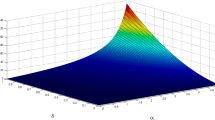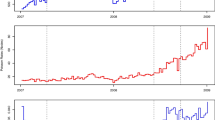Abstract
We investigate the joint distribution of nodes of small degrees and the degree profile in preferential dynamic attachment circuits. In particular, we study the joint asymptotic distribution of the number of the nodes of outdegree 0 (terminal nodes) and outdegree 1 in a very large circuit. The expectation and variance of the number of those two types of nodes are both asymptotically linear with respect to the age of the circuit. We show that the numbers of nodes of outdegree 0 and 1 asymptotically follow a two-dimensional Gaussian law via multivariate martingale methods. The rate of convergence is derived analytically. We also study the exact distribution of the degree of a node, as the circuit ages, via a series of Pólya-Eggenberger urn models with “hiccups” in between. The exact expectation and variance of the degree of nodes are determined by recurrence methods. Phase transitions of these degrees are discussed briefly. This is an extension of the abstract (Zhang 2016).
Similar content being viewed by others
References
Barabási A, Albert R (1999) Emergence of scaling in random networks. Science 286:509–512
Berger N, Borgs C, Chayes J, Saberi A (2014) Asymptotic behavior and distributional limits of preferential attachment graphs. Ann Probab 42:1–40
Billingsley P (1995) Probability and measure, 3rd. Wiley, New York
Bollobás B, Riordan O, Spencer J, Tusnády G (2001) The degree sequence of a scale-free random graph process. Random Struct Algoritm 18:279–290
Dereich S, Ortgiese M (2014) Robust analysis of preferential attachment models with fitness. Combin Probab Comput 23:386–411
Drmota M, Gittenberger B, Panholzer A (2008) The degree distribution of thickened trees. In: The proceedings of the 5th colloquium on mathematics and computer science, Kiel, Germany, pp 149– 161
Fuchs M, Hwang H, Neininger R (2006) Profile of random trees: limit theorems for random recursive trees and binary search trees. Algorithmica 46:367–407
Gopaladesikan M, Mahmoud H, Ward M (2014) Asymptotic joint normality of counts of uncorrelated motifs in recursive trees. Methodol Comput Appl Probab 16:863–884
Hwang H (2007) Profiles of random trees: plane-oriented recursive trees. Random Struct Algoritm 30:380–413
Kholfi S (2012) On a class of zero-balanced urn models (Ph.D.Thesis). The George Washington University, Washington, D.C
Küchler U, Srensen M (1998) A note on limit theorem for multivariate martingales. Bernoulli 5:483– 493
Mahmoud H (2009) Pólya Urn Models. CRC Press, Boca Raton
Mahmoud H (2014) The degree profile in some classes of random graphs that generalize recursive trees. Methodol Comput Appl Probab 16:643–673
Mahmoud H, Tsukiji T (2004) Limit laws for terminal nodes in random circuits with restricted fan-out: a family of graphs generalizing binary search trees. Acta Inform 41:99–110
Mahmoud H, Smythe R, Szymański J (1993) On the structure of plane-oriented recursive trees and their branches. Random Struct Algoritm 4:151–176
Merton R (1968) The Matthew effect in science. Science 159:56–63
Moler J, Plo F, Urmeneta H (2013) A generalized Pólya urn and limit laws for the number of outputs in a family of random circuits. TEST 22:46–61
Ostroumova L, Ryabchenko A, Samosvat E (2013) Generalized preferential attachment: tunable power-law degree distribution and clustering coefficient. In: The proceedings of the 15th international workshop on algorithms and models for the web graph (WAW2018), Moscow, Russia, pp 185–202
Peköz E, Röllin A, Ross N (2013) Degree asymptotics with rates for preferential attachment random graphs. Ann Appl Probab 23:1188–1218
Peköz E, Röllin A, Ross N (2016) Generalized gamma approximation with rates for urns, walks and trees. Ann Probab 44:1776–1816
Peköz E, Röllin A, Ross N (2017) Joint degree distributions of preferential attachment random graphs. Adv in Appl Probab 49:368–387
Resnick S, Samorodnitsky G (2016) Asymptotic normality of degree counts in a preferential attachment model. Adv in Appl Probab 48:283–299
Ross N (2013) Power laws in preferential attachment graphs and Stein’s method for the negative binomial distribution. Adv in Appl Probab 45:876–893
Tsukiji T, Mahmoud H (2001) A limit law for outputs in random circuits. Algorithmica 31:403–412
van der Hofstad R (2016) Random graphs and complex networks, vol 1. Cambridge University Press, Cambridge
Wang T, Resnick S (2017) Asymptotic normality of in- and out-degree counts in a preferential attachment model. Stoch Models 33:229–255
Zhang P (2016) On terminal nodes and the degree profile of preferential dynamic attachment circuits. In: The proceedings of the 13th workshop on analytic algorithmics and combinatorics (ANALCO16), Arlington, VA, pp 80–92
Acknowledgements
The authors would like to thank the associate editor and an anonymous referee for insightful discussions and helpful comments that improved the quality of the paper. The second author wishes to thank Center for Complex Network Research for hosting his sabbatical visit. In particular, he thanks Albert-László Barabási for providing the opportunity.
Author information
Authors and Affiliations
Corresponding author
Additional information
Publisher’s Note
Springer Nature remains neutral with regard to jurisdictional claims in published maps and institutional affiliations.
Appendix
Appendix
1.1 A.1 Coefficients in Proposition 2
1.2 A.2 Exact Moment of \(\mathbb {E}[B^{2}_{n}]\) in Proposition 3
Rights and permissions
About this article
Cite this article
Zhang, P., Mahmoud, H.M. On Nodes of Small Degrees and Degree Profile in Preferential Dynamic Attachment Circuits. Methodol Comput Appl Probab 22, 625–645 (2020). https://doi.org/10.1007/s11009-019-09726-4
Received:
Revised:
Accepted:
Published:
Issue Date:
DOI: https://doi.org/10.1007/s11009-019-09726-4




